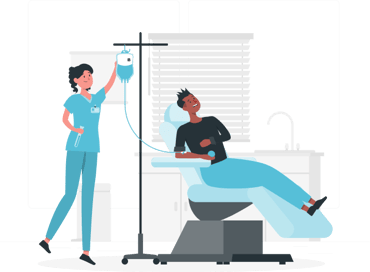Health Spending Accounts For Canadians Explained
A Health Spending Account (HSA), also known as a Health Care Spending Account (HCSA) or Health...

By Simply Benefits Marketing
February 15, 2022
Whether you have had employee benefits for years or are just getting started with a new employer, the world (and jargon) of Canadian group health insurance plans can be daunting and at times overwhelming. We broke down some of the most common benefits so you can better understand what they are and how they work.
Before we jump into the details of employee health benefits, it's important to understand that plan coverage varies from employer to employer; therefore, it's important employees consult your organization's benefits booklet for details of your specific coverage.
Here are some common terms you may find helpful to learn as you read this blog:
Life Insurance is money (or benefit) paid by the insurer to an employee’s beneficiary in the event of their death. A beneficiary is an individual or individuals named by the employee on their benefits plan that will receive a payout (aka the benefit) in the event of the employee’s death. This individual is normally a spouse, child(ren) or family member.
The group life insurance benefit is determined by the employer and can be a:
Some employers also offer Optional Life Insurance which allows employees to purchase (typically through payroll deduction) additional insurance over and above the Basic Life Insurance coverage provided by the employer's benefits plan. Depending on the requested coverage limit, employees may be required to provide the insurer with medical evidence like health exams, blood tests and medical history records.
Also Read: How Employee Group Life Insurance Works
Dependent Life insurance is similar to “Basic Life Insurance”, except it provides coverage for the employee’s dependents in the event of their death. A dependent could include a spouse, common-law partner or child. Generally, the benefit paid is less than an employee's coverage and is meant to cover after-death expenses (e.g. funeral costs, etc.)
Accidental Death & Dismemberment (AD&D) coverage is in the event of an accident which may result in the employee's death and/or loss of limb or other severe injuries (loss of sight, speech, hearing, paralysis, coma, etc.). Although we hope we won’t ever need this coverage, it’s invaluable for employees, and their families, in the event it does. This benefit is normally sold as part of a Life Insurance policy rider (aka comes as a package deal) and equals the same benefit amount of the Life Insurance maximum (total coverage amount).
Similar to Life Insurance, the amount that the beneficiary receives for both is generally either a flat amount or a graded amount and is determined by the employer.
When group AD&D is sold as a rider with Life Insurance, instead of separately, the benefit paid will be twice the amount of the original face value in the event of accidental death. Basically, if the employee’s death is an accident, their beneficiary will receive a payout for their Life Insurance maximum and AD&D maximum.

Example:
AD&D also offers the employee financial support if they were to lose a limb (leg, arm, finger, hand, etc.) or other body functions (eyesight, hearing, etc.). The financial amount they will receive for the loss of body function depends on what is lost, for example, an employee will receive more if they were to lose a leg vs. a finger.
Dental coverage is one of the most commonly used employee benefits, as most people get regular preventive cleanings and check-ups.
Dental coverage is normally split into three categories:
Dental plans can assign individual maximums (coverage amounts) to Basic, Major, and Orthodontics, or they may combine Basic and Major so that the maximum is split between both.
Read: How the Dental Fee Guide Impacts Your Employee Benefits Plan.
Example:
Note: Most orthodontic work has a termination age of 18, and is mainly used for the employee’s children.
Healthcare benefits cover a lot of supplemental health costs that are not included in the Canadian public health care plan. Healthcare is divided into subsections, normally including:
Normally, each one of the above Healthcare categories (Major Health, Paramedical, Vision, and Travel), are included and priced individually. Employees may have a health plan that only covers some of these categories (e.g. Paramedicals and Vision for example).
Examples:
Extended Health is the most extensive benefit, so there are many ways a plan can be designed and priced. If you have more questions, we’re here to help! Talk to one of our digital benefits experts today.
 Prescription Drugs
Prescription DrugsPrescription drugs are another well-known and frequently used health benefit. This benefit generally covers a certain percentage of the costs for prescriptions and dispensing fees. Most employers have a pre-approved list of drugs (aka drug formulary) that can be reimbursed, and often there is a mandatory generic substitute requirement.
Payment Options
Short Term Disability (STD) is a benefit offered to employees who are unable to work due to accident, injury, or illness for the short-term. STD generally protects employees for 17 weeks (on average), and covers 60-70% of their salary. If an employee requires more time away from work and has maxed out their coverage for STD, then they may qualify for Long Term Disability (depending on their illness/injury) if/when included as part of an employee benefits plan.
Not all employers offer STD as a benefit to employees as most employees are eligible for financial compensation through Canada's Employment Insurance Sickness Benefits. EI Sickness Benefits provide financial support for up to 15 weeks and a maximum of $595 per week (in 2021) or $638 per week (in 2022) minus taxes.
Learn more about EI Sickness Benefits and the benefits of providing STD in our blog Changes to 2022 Maximum Insurable Earnings for Canadian Employment Insurance.
Long Term Disability (LTD) is offered to employees that face major health concerns and are unable to work due to accident, injury, or illness unrelated top their job (if job-related, then employees would receive benefits through their provincial Workers Compensation program. See the Canadian Centre for Occupational Health and Safety for a list of provincial WCBs.
Critical Illness pays employees a tax-free, lump sum payment if they are diagnosed with a serious illness (as specified by the insurer) and survives an initial period of time.
specified by the insurer) and survives an initial period of time.
This coverage helps protect employees who have to pay additional or unexpected expenses caused by their illness. Employees choose how they want to spend the lump sum payment.
Some examples of critical illnesses are:
Note: Coverage may vary depending on how extreme the illness is and if an employee has a pre-existing condition. For example, if an employee has an illness that can be cured quickly with limited downtime, they may not qualify.
Spending Accounts have gotten extremely popular in recent years and can be divided into two types:
Health Spending Account (HSA)
More and more organizations, especially small businesses, are turning to HSAs to keep costs low while offering employees health coverage. Employers only pay for what their employees use, so if they offer $1,000 annually and an employee only uses $300 of that amount, the employer only pays $300.
Employees can be reimbursed for health-related products or services providing the expense qualifies as eligible dictated by the Canada Revenue Agency (CRA) and are the same as the medical expenses that could otherwise be claimed on an individual's tax return.
Annually, employers provide employees with a budget of money to use (frequently between $1-5K annually) to purchase health services or top off an existing health claim that wasn’t 100% covered. Examples of what employees can use their HSA for include: top-offs (drugs, services), Massage, Dental, etc.
HSAs are a non-taxable benefit, meaning employees will not be taxed for the amount spent/reimbursed, similar to their regular health benefits.
Note: If employees have an HSA along with a comprehensive health plan (Drugs, Dental, Healthcare) they need to submit their claim through their regular health plan first. They can only submit drugs/services through their HSA if they have reached their plan’s maximums, are using it to top-off a claim, or do not have any other coverage to submit their claim to first.
Lifestyle Spending Account (LSA)
Similar to HSAs, employers provide employees with a budget of money to use on an annual basis. LSAs generally provide employees more freedom than an HSA as reimbursable expenses are not dictated by the CRA; however, employers can put parameters on what employees can purchase (if they chose to), or leave the LSA completely flexible. Depending on plan parameters, employees can purchase transit passes, gym memberships, ski passes, workout clothing, etc.
Similar to HSAs, employers only pay for what their employees use. The only downside to LSAs is that they are a taxable benefit, and are considered taxable income for employees.
The key difference between a Health Spending Account and a Lifestyle Spending Account is that the HSA must be spent on health-related items, whereas the LSA can be spent on most anything the employee wishes (within the employer’s parameters).
Fun Fact: Employers can allow spending account balances to roll over to the next year (up to a certain amount of their choosing) or not (use-it-or-lose-it). Roll over provides their employees with more freedom.
If this sounds like a great option for your business, then reach out to one of our experts to learn if a Spending Account is the right option for you.
Hopefully, you now know the basics of Employee Health Benefits coverage, whether you’re an employee or an employer. Not only do we offer all these benefits here at Simply Benefits in a customizable plan, but we provide them 100% digitally so employees and employers never need to fill out paperwork again.
If you're an employer and would like to learn more about Simply Benefits, working with Simply Benefits as your digital Employee Benefits provider, contact us and we'll introduce you to one of our knowledgeable Benefits Advisor partners.
Disclaimer: Please note that the information provided, while authoritative, is not guaranteed for accuracy and legality. If you are a Simply Benefits plan member, you can look up more information on your specific plan coverage under the “Plan Coverage” section on your account, or speak to your administrator for more information.
If you're an employee looking for help to better understand your group benefits plan, check out these resources:
Simply Benefits is Canada's newest Third Party Payor (TPP) that provides Employee Health Benefits 100% digitally through our Canadian Advisor partners. Our all-in-one digital solution provides three portals that enable Benefits Advisors to digitally manage all client plans online, Employers to efficiently administer employee coverage, and Employees to view, update and use their benefits 24/7 via desktop or smartphone app.
We help ENGAGE Employees Anytime, Anywhere, SIMPLIFY the Benefits Experience, and EVOLVE an Advisors’ Benefits Business.
Connect with us at simplybenefits.ca or on LinkedIn, Twitter, Facebook, Instagram, and YouTube.
Employee Benefits Made Simple.

Terms + Conditions
Simply Benefits Inc. (“us”, “we”, or “Simply Benefits”) is committed to privacy and the protection of your information. By using Simply Benefits’s website, mobile and other applications, and related Services made available through the Apple App Store, the Google PLAY Store, or otherwise on the Internet (together, the “Simply Benefits Applications” or “Applications”), you acknowledge that you accept the practices and policies outlined in this Privacy Policy (“Privacy Policy“). Unless otherwise defined herein, capitalized terms shall have the meanings assigned to such terms set forth in the Terms of Service and which incorporate this Privacy Policy by reference.
